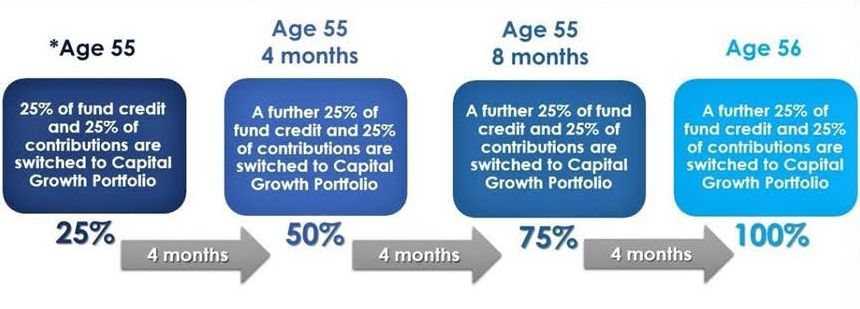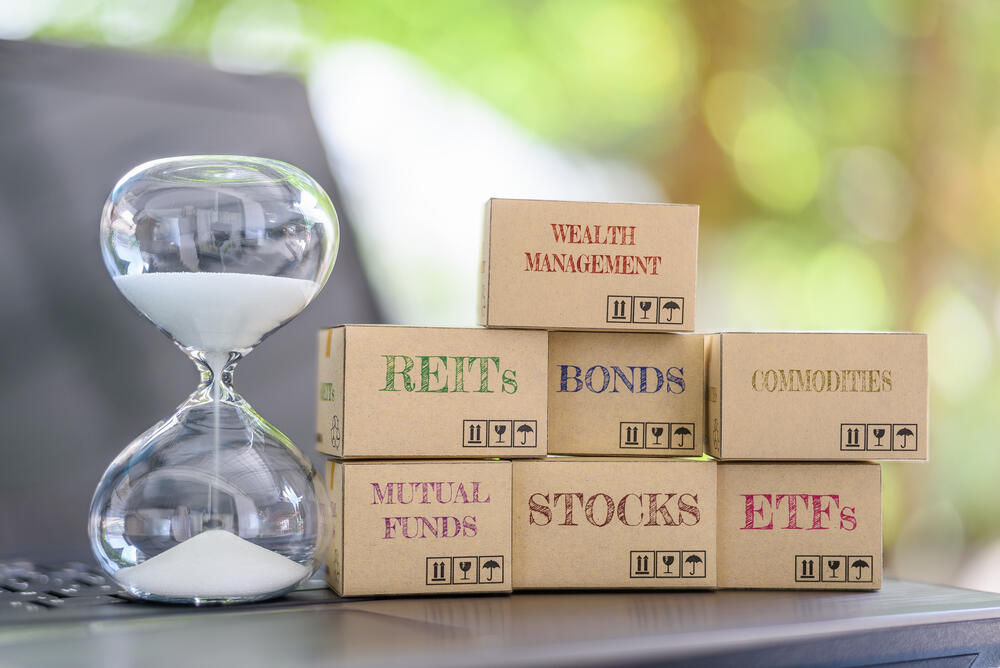Investments
Life stage (default)
The fund applies a life stage model which automatically takes members through different investment portfolios i.e. aggressive to more conservative portfolios as they near retirement age. The life stages are as follows:
- Members younger than age 55 - Aggressive Growth portfolio
- Members age 55 and older, but younger than age 62 -Capital Growth portfolio
- Members age 62 and older - Stable Growth portfolio
The fund has implemented a phasing-in approach for default switches. Read more
The first 25% switch to the new recommended portfolio will commence at the end of a member’s birthday month. As a result, it will take 12 months for a total portfolio switch to be completed. After the 12 month phase-in period, all future member contributions will automatically accrue to the new default life stage portfolio. See an illustration of a default switch from the Aggressive Growth portfolio to the Capital Growth portfolio below.

*The first 25% switch to the new recommended portfolio will commence at thee end of a member's birthday month.
Member investment choice
The fund also allows flexibility in providing our members with the option to elect any of the individual investment portfolio options available.
Investment switch form
Aggressive Growth Portfolio
Investment objective: To maximise capital growth over a long-term investment horizon. Members should acknowledge that this strategy could deliver volatile and negative returns over the short-term. This strategy is suitable for members with more than 10 years to retirement.
Capital Growth Portfolio
Investment objective: :To target capital growth over a medium to long-term investment horizon. Members should acknowledge that this strategy could deliver volatile and negative returns over the short-term. This strategy is suitable for members with 5 to 10 years to retirement.
Stable Growth Portfolio
Investment objective: To target stable returns over a medium-term investment horizon with low volatility and a low probability of negative returns. This strategy is suitable for members with 1 to 5 years to retirement.
Capital Protector Portfolio
Investment objective: To provide capital security with very low volatility and an extremely low probability of negative returns. This strategy is suitable for members with less than 1 year to retirement where capital protection is absolutely necessary
Shari’ah portfolio
This portfolio is suitable for Muslim investors requiring a Sharia-compliant investment portfolio. The portfolio will be invested in a variety of domestic and international asset classes. The underlying investments will comply with Shari'ah requirements as prescribed by the Auditing Organisation for Islamic Financial Institutions. The portfolio targets capital growth over the long-term while limiting short term market fluctuations.
Latest investment returns

Economic Commentary: May 2025
Global markets rallied in May, led by the US, as President Trump delayed the imposition of tariffs on the EU and a US trade court blocked all tariffs emanating from the International Emergency Economic Powers Act.
In the US, the Court of International Trade blocked most of President Donald Trump's tariffs in a sweeping ruling that found the president overstepped his authority by imposing across-the-board duties on imports from U.S. trading partners. The Court said the U.S. Constitution gives Congress exclusive authority to regulate commerce with other countries that is not overridden by the president's emergency powers to safeguard the U.S. economy. The court however was not asked to address some industry-specific tariffs Trump has issued on automobiles, steel and aluminium, using a different statute, and those remain in place. Meanwhile, inflation ticked up slightly in April (+0.2% m-o-m) but the annual rate declined slightly to 2.3% in April from 2.4% in March. The effects of tariffs aren't yet clear, and this may be due to the timing mismatch of when goods arrived in the U.S. and when businesses adjust prices. May's data will likely be a more helpful indicator of the pass-through from tariffs to consumer prices. Consumer spending, though, slowed sharply for the month, increasing by just 0.2% as consumer confidence fell with the increased economic uncertainty. Declining confidence was also reflected in the personal savings rate which jumped to 4.9% - the highest level in nearly a year. Trump has been pushing the Fed to lower its key interest rate as inflation approaches the central bank's 2% target, but policymakers have been hesitant to move as they are worried that tariff-induced inflation, particularly when the labour market appears to be slowing could bring about a period of stagflation, a phenomenon the U.S. hasn't seen since the early 1980s.
Global investors shrugged off fears of a slowdown in the US as markets rallied on the announcement of a 90-day negotiating period with certain trading partners including Europe, as well as the blocking of other tariffs by the court. The MSCI World Index ended the month with gains of 5.9% driven by gains in Information Technology, Consumer Discretionary and Communication Services stocks. The S&P500 ended the month with gains of 6.3% while the NASDAQ rallied 9.1%. Germany's DAX gained 6.7% as the nation benefited from the pause in tariffs, while Japan's Nikkei Index added 5.3%. Emerging markets gained 4.3% as gains in Eastern Europe were offset by lower returns from China and Brazil. Global bond markets declined 0.4% as the yield on the 10-year US Treasury rose to 4.4% in May, following a rating downgrade by Moody's, while global property stocks gained 2.4% as the sector benefited from the rally in equities.
In South Africa, Finance Minister Enoch Godongwana presented a less controversial Budget 3.0 that was met with relief as the proposed VAT hike was formally scrapped and the only new tax proposed was the increase in the fuel levy for the first time in three years. SARS has been allocated an additional R7.5 billion over the next three years to increase their effectiveness in collecting more revenue, and the tax collector believes it can collect enough taxes to plug the spending gap. The budget also provides for a reduction in government spending, and improvements in oversight and operations. Inflation meanwhile rose to 0.3% in April, raising the annual rate to 2.8%, slightly higher than March's 2.7% as the cost of housing and utilities, food and beverages, and restaurants and accommodation services rose. Meanwhile, the SARB lowered interest rates by 0.25% as widely expected with the Monetary Policy Committee noting that the backdrop of lower oil prices, a stronger rand, and receding global uncertainty, allowed the MPC to continue with policy easing. At the same time, the central bank sharply downgraded its economic growth outlook following the release of disappointing high-frequency indicators. Data showed contractions in manufacturing, mining, construction activity, and wholesale trade, along with sluggish retail and vehicle sales, and the Bank now expects GDP growth of just 0.1% in the first quarter, and 1.2% for the year (from 1.7% previously). This is broadly in line with the IMF's expectation of 1% growth for the year.
Local equity markets followed global markets higher. The All Share Index gained 3.1% for the month (+14% year-to-date) driven by double digit gains in platinum miners, diversified miners and a 6% gain in Naspers. Industrials stocks gained 4% in aggregate, while resources added 2.6% and financials gained 2.1%. The rand strengthened 3% for the month as the political environment stabilised and the revised budget was welcomed by investors. Local bonds gained 2.7% for the month as investors expected an improvement in the country's fiscal situation. Listed property stocks gained 2.3% in May as the sector benefited from lower interest rates and improved sentiment.
 NFMW AG FFS May 2025
NFMW AG FFS May 2025
 128 kb
128 kb
 NFMW CG FFS May 2025
NFMW CG FFS May 2025
 125 kb
125 kb
 NFMW SG FFS May 2025
NFMW SG FFS May 2025
 154 kb
154 kb
 NFMW CP FFS May 2025
NFMW CP FFS May 2025
 132 kb
132 kb
 NFMW Sharia FFS May 2025
NFMW Sharia FFS May 2025
 146 kb
146 kb
Investment policy statement
Investments FAQs




 Cookie Notice
Cookie Notice Cookie settings
Cookie settings